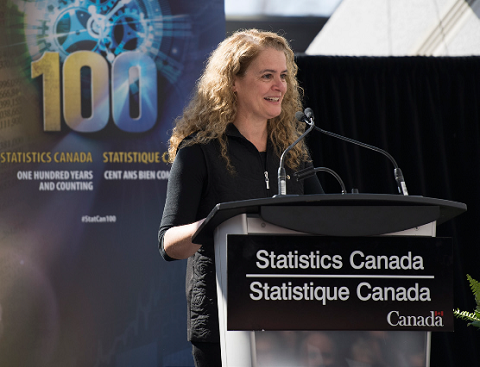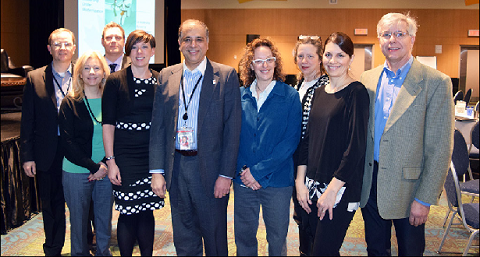- 88% of Canadians trust Statistics Canada—a higher score than other government institutions, banks, polling companies and media (Source: Survey of Canadians' views on Statistics Canada, summer 2018).
- One of Canada's Top Employers for Young People in 2018.
- One of the National Capital Region's Top Employers in 2018.
Table of Contents
- Message from the Chief Statistician of Canada
- One Hundred Years and Counting: Statistics Canada's centennial year
- Ensuring statistical programs remain relevant
- Increasing access to data and microdata to drive innovation and inclusion
- Mobilizing data using Statistics Canada's expertise as a world-leading data steward
- Increasing data literacy by building statistical capacity
Message from the Chief Statistician of Canada

It is a great pleasure to showcase our collective accomplishments in 2017/2018 in this second edition of the Year in Review. This past year, Statistics Canada has been undergoing a period of exciting transformation. The many initiatives and projects featured here demonstrate the impact that we have on the lives of Canadians, and remind us all that our work serves a fundamental purpose. Together, we should be proud of our individual and collective contributions to modernizing Statistics Canada and helping to create a Canada with a data-driven society and economy.
Our work has just begun. We will continue to expand our role as Canada's national statistical agency to help Canadians understand and interpret statistics. We will deepen our collaboration with clients, stakeholders and partners to share best practices and expertise, build capacity, and generate new, innovative ideas. And, we must continue to modernize each step of the statistical process, and our workforce, so that we can take advantage of the many opportunities that our digital environment provides.
I encourage you—the backbone of this agency—to continue to aim high. I look forward to another successful year ahead. Thank you for all that you do.
Anil Arora
Chief Statistician of Canada
One Hundred Years and Counting: Statistics Canada's centennial year

Governor General Julie Payette delivering a speech to nearly 500 employees during the official launch of Statistics Canada's centennial celebrations in the Jean Talon Cafeteria on March 16, 2018.
One Hundred Years and Counting: It's been quite the statistical century! In 2018, Statistics Canada turned 100 years old. Since 1918, the agency has played a pivotal role in the life of the nation, gathering information Canadians want and need. To mark this important milestone, Statistics Canada held a series of activities and events for staff, data users and Canadians to honour a century of growth and shed light on an even brighter future.
Centennial events and activities include:
- the official launch with Her Excellency the Right Honourable Julie Payette, Governor General of Canada
- a Happy Birthday StatCan event for staff which included a historical video from the 1971 Census to celebrate the passing of the Statistics Act on May 24, 1918
- a panel discussion with Statistics Canada alumni
- a historical exhibition at Library and Archives Canada
- a national consultation week in recognition of World Statistics Day
- a conference with the Association for Canadian Studies
- an e-book showcasing the vital role that Statistics Canada continues to play in the history of our country
- a weekly #ThrowbackThursday series on social media.
- And, much more
Ensuring statistical programs remain relevant
Supporting modernization: With modernization at the top of our agenda, managers and employees are adapting to new realities, evolving to meet the needs of Canadians, and providing sound advice on the agency's modernization through a series of activities and events. This year, the agency's Executive Management Board was restructured into four new committees, each with a clear mandate to facilitate experimentation, innovation and action.
New executive management committees
- Strategic Management Committee
- Corporate Planning Committee
- Modernization Management Committee
- Operations Committee.
Modernization in action
All levels of Statistics Canada's management team made important contributions to the agency's transformation this year, discussing their ideas and vision for the future at a number of events, including:
- the 2018 Middle Managers' Conference, an annual meeting to share information, stimulate ideas, and encourage networking and discussion
- a one-day leadership engagement session for directors general
- a one-day strategic planning session for assistant chief statisticians.

Chief Statistician Anil Arora with the organizing committee of the 2018 Middle Managers' Conference held in February in Gatineau, Quebec.
As Statistics Canada's backbone, employees are eager to learn about and discuss modernization ideas and activities. They used a variety of platforms, including:
- an organizational culture profile survey
- two town hall sessions about modernization and the modern and flexible workplace
- sessions to develop a vision statement to help guide the transformation
- working groups with modernization "change agents" to brainstorm ideas about where the agency is going and how it's getting there
- a series of one-hour presentations on the four pathfinder projects
- the Modernization Bulletin, a new monthly newsletter that provides updates on modernization and the people and ideas behind it.

Statistics Canada employees at a town hall session held in June 2018.
A growing framework: Today, Statistics Canada is developing a suite of economic and social indicators on the consumption, production and distribution of cannabis from 1961 onwards, thanks to a number of innovative projects, surveys and technological solutions. These include crowdsourcing cannabis data collection, using wastewater to estimate aggregate consumption and conducting the quarterly National Cannabis Survey. Not surprisingly, the agency's green file garnered a significant amount of media and international attention for taking a leading-edge approach to measuring what is still an illegal substance.

James Tebrake, Director General of the Macroeconomic Accounts Branch, was the recipient of the 2018 APEX Award of Excellence for Innovation.
That's a wrap on 2016! To 2021, and beyond…
The census is the agency's largest program, and the past year marked an important transition between census years:
- The Census Program achieved its goal of completing its main releases within 18 months of Census Day, providing greater use of timely data to our users.
- Statistics Canada finished releasing the 2016 Census of Agriculture data, which showed how the sector is moving away from traditional family farms toward corporate agricultural operations. More extensive outreach efforts took place in 2017/2018, and more than 300 thematic maps were loaded onto the Federal Geospatial Platform.
- The Census Program Transformation Project continued to develop the Statistical Population Register, and the first version of the Statistical Building Register was completed. Together, these registers could be the foundation of a future census model, combining data from administrative sources with data from direct enumeration.
- The Census Program continues to develop new tools, including a variety of interactive charts on income, immigration and labour, and a new dashboard—the Census Program Data Viewer, an advanced web-based data visualization tool.
- Thousands of staff are being hired in preparation for the 2021 Census. An innovative approach to personnel security screening is automating and speeding up parts of the process. This will eventually be adopted agency-wide.
- From September 2017 to February 2018, Statistics Canada received more than 2,800 online submissions during the public consultation on how census data are used, making it the most expansive census consultation to date. Statistics Canada also held about 60 discussions with Indigenous groups across the country and met with numerous federal government stakeholders and advisory committees about the 2021 Census. Preliminary findings reveal that two-thirds of data users are satisfied with current census content.

From left to right: Jane Badets, Marc Hamel, Connie Graziadei, Anil Arora and Gabrielle Beaudoin cut the cake at an event celebrating the final release of the 2016 Census.
Supporting Canada's transportation network and infrastructure: In 2017, the Government of Canada announced funding to build the Canadian Centre on Transportation Data, which includes the Transportation Data and Information Hub on the Statistics Canada website. Developed in partnership with Transport Canada, the virtual data centre is designed to increase Canadians' understanding of the transportation sector and its economic and social role. Early achievements include publishing the Canadian Freight Analysis Framework, and releasing the Canadian Transportation Economic Account and the Infrastructure Economic Account.
Enriching Canadians' understanding of clean tech: In support of the Pan-Canadian Framework on Clean Growth and Climate Change, Statistics Canada is working to improve its data on clean technology by redesigning the Environmental and Clean Technology Products Economic Account and the Survey of Environmental Goods and Services.
Increasing the timeliness and relevance of data: Responding to the need for more timely information on hate crimes in Canada, Statistics Canada released these data seven months earlier than in previous years. Income estimates from the 2017 Canadian Income Survey were also released two months sooner—making it the earliest release in more than 20 years.
Learning more about the digital economy: Canada's digital economy is transforming the ways in which goods and services are delivered to, and consumed by, Canadians. To learn more about what's called the "sharing economy," Statistics Canada conducted a rapid response survey of households on their use of digital platforms and technologies. Similarly, a new digital economic account was developed in collaboration with U.S. counterparts.
Reporting on the public service: With 86 participating departments and agencies in 2017, Statistics Canada conducted the largest Public Service Employee Survey (PSES) to date. The 2017 PSES results provided reliable and timely information on the views of employees on many aspects of their workplace, workforce and leadership, and the agency did this in a more cost-effective and timely manner than before.
Reinstating the University and College Academic Staff System (UCASS): In 2016, Statistics Canada reinstated UCASS and released its data six months earlier than before. Now, the agency is partnering with provincial education ministries, national education associations and other departments to include colleges and part-time teachers, and to collect information on equity, diversity and inclusion in the academic community. Leading-edge methods are being used to forecast the participation of women in academia and their career trajectories.
Modernizing statistical programs: As the agency continues to modernize its Labour Statistics Program, it is also engaging with data users in new and interesting ways, including on Reddit. Other work is underway to use Power BI as a visualization tool for monthly labour results, and the agency is working with its key partners and international labour bodies to improve its measurement of non-standard employment and the quality of work.
For the General Social Survey (GSS), Statistics Canada is using user-centric design techniques and innovative tools such as Reddit to raise awareness of, and participation in, the GSS and to glean more insights from Canadians on social data needs. Design testing for the GSS on Time Use is also underway, as well as the exploration of applications to collect data on time use, well-being and other diary-based data.
Redesigning surveys and using faster collection tools: In 2017/2018, the Operations and Integration Division redesigned and enhanced more than 120 surveys in partnership with subject-matter areas. Smaller, more concise collection tools such as Rapid Stats surveys and fast-track options were also developed and promoted across the agency for topics such as opioid awareness.
Maintaining survey collection activities in the regions: Even with the increased use of administrative data, a strong need for surveys and data collection across the country will remain. The agency's computer-assisted personal interviewers and computer-assisted telephone interviewers continued to carry out this role in 2017/2018, making more than 14.0 million phone calls for nearly 250 surveys.
Improving collection operations: A research unit has been working to monitor and report on the changes in collection operations to reduce the number of follow-ups to respondents. Over the past few years, this research has had a direct impact on response rates. For the National Graduates Survey, for example, the agency's expected response rate was 15%, but it is currently surpassing this target and is sitting at 35%.
An innovative procurement strategy: Thanks to the recent successes of Statistics Canada's procurement strategy, the agency is now a member of the government-wide Agile Procurement Working Group. Other activities are also underway to make procurement processes simpler and less burdensome for Canadians.
Modernizing the Statistical Information Service: It has been a busy year for this team, which saw user demand peak with the final releases of census data. In addition to this work, the focus has been on modernizing the services offered through the regions and creating a nation-wide network of data service centres (DSCs). Working with partners across the agency, these centres will act as hubs for client service provision, outreach, statistical capacity building and alternative data discovery. The first DSC is projected to launch in Toronto later this fall.
Increasing access to data and microdata to drive innovation and inclusion
Leading the Government of Canada Data Strategy: As Statistics Canada is well aware, data are transforming how governments interact with citizens, businesses, organizations and each other, forcing organizations to shift their focus, build new expertise and devise new ways of working.
Recognizing the key role Statistics Canada is playing in the data revolution, the Clerk of the Privy Council Office (PCO) invited the agency to join forces with PCO and Treasury Board Secretariat to spearhead a Government of Canada Data Strategy to ensure data are used as a strategic asset across the federal government and its partners. Goals include ensuring better governance, increasing evidence-based decision making, improving services to Canadians, and providing greater usability and availability of data.
The Clerk received an interim report in April 2018, and a final report will be submitted in September. This work, like Modernization itself, is an opportunity for Statistics Canada to shine, and demonstrate its capacity, expertise and enthusiasm to better support the Public Service of Canada.
Government of Canada Data Strategy Guiding Principles
- Client-centred
- Purposeful
- Trusted
- Agile
- Open
- Enabling
Mobilizing international statistics: International trade and foreign investment dominated Canadian economic policy in 2017/2018. Over the past year, Statistics Canada significantly increased the amount of data available to policy makers in support of ongoing trade negotiations. The agency undertook a reconciliation study with China on trade in goods and services, and expanded the Canada and the World Statistics Hub—an online portal that provides information related to Canada's economic and financial activity in the world. The agency also released new data on the integration of the Canadian economy in global value chains. For example, Statistics Canada can now report the value of U.S. imported content embedded in a car exported out of Ontario, or the number of jobs in British Columbia generated by goods exported from Alberta to the United States.
Sharing and collaborating with colleagues: In 2018, Statistics Canada hosted the Human Resources (HR) Data Analytics Open House for nearly 90 HR specialists from 41 federal institutions and the University of Ottawa. The event showcased results from the 2017 Public Service Employee Survey using the business analytics tool Power BI. Since April 2018, employees from across the public service have accessed approximately 20,000 reports per month, and Statistics Canada has established 15 partnerships with other government departments to give advice and support in analyzing HR data.
Increasing virtual access to data: In partnership with Compute Canada, work is underway to modernize the IT infrastructure in Statistics Canada's research data centres (RDCs) to build on the agency's business and security processes, and foster greater access to data for academic and policy research. The agency is also piloting virtual infrastructure that provides access to linked administrative and business data for its federal and provincial partners. More than 80 new files have been added to the RDC collection since April 2017.
Providing data analytics as a service: The Informatics Branch is establishing data analytics as a service, which will enable the delivery of business capabilities in a more agile, responsive manner. Key components include a data management hub, data ingestion services, data analysis using artificial intelligence, machine learning techniques and high-performance data processing. It will also enable others to use the data and increase the presence of Statistics Canada products on a larger scale across Canada. External partners will be able to collaborate, through new leading-edge tools and easy access to more data.
Digital innovation: The Informatics Branch created the Innovation (Tech) Radar, capturing experimental activities, techniques and technologies across the agency and organizing them by relevance, maturity, vendor and subject. The branch also provided a transparency tool that lets all players across the agency see what is going on in the experimental "mode 2" space. These innovations are helping increase access to data—which, in turn, is fuelling more innovation.
Developing and piloting new tools: The Random Tabular Adjustment prototype, developed in methodology, has been designed to increase access to tabular data. It was piloted with several business surveys. The Analytical Studies Branch also piloted the Canadian Synthetic Longitudinal Business Database, facilitating new research and improving access to business microdata. In geomatics, the agency continued to adopt new technologies for collecting and disseminating data in spatial dimensions, including new "map-to-data" features on the Statistics Canada website for geospatial visualization, research and analytics. The agency also piloted the use of satellite imagery for the National Road Network, and collected Global Positioning System coordinates to assist with the number of dwellings for social surveys and the building register.
Bringing gender and diversity into focus
Gender-based Analysis Plus (GBA+) is an analytical tool to assess how groups of women, men and gender-diverse people are affected by various policies, programs and initiatives.
- Centre for Gender, Diversity and Inclusion: Tied to initiatives launched by the Government of Canada, and in collaboration with Status of Women Canada, Statistics Canada is developing a Centre for Gender, Diversity and Inclusion Statistics. The Centre will report on gender, diversity and inclusion in Canada, generate new information and build statistical capacity for analyzing data and statistics, helping other departments with their commitments to GBA+.
- Reporting on unfounded criminal incidents: In 2006, Statistics Canada decided to no longer publish data on unfounded incidents. In 2017, there were significant public discussions around sexual violence in news reports and on social media, which may have had an impact on the willingness of victims to report sexual assaults to police. In 16 months, together with the policing community and other stakeholders, Statistics Canada reached national consensus on new definitions, developed and provided training, and reinstated data collection on unfounded incidents for all crimes, including sexual assaults. This culminated in the release of a report and the dissemination of new data on unfounded incidents on July 23, 2017.
- The Survey of Safety in Private and Public Spaces was launched in April 2018 to improve information on the nature and extent of various forms of gender-based violence in the general population. The survey results will include new indicators of intimate partner violence, and sexual and physical assault. The agency is working on other data collection initiatives focused on gender-based violence in the workplace and among postsecondary students, helping to lay the foundation for greater action on gender-based violence in Canada.
Finding data just got easier: Based on feedback from its users, the agency is changing the way it disseminates information to take advantage of evolving technology, increase user satisfaction, and make it easier for users to find the data they need. Data users can now harvest online data for further analysis in their own environment through the agency's web data services.
Other significant improvements and activities:
- A new public opinion research survey was conducted in 2018, and an extensive client satisfaction survey will be launched later in 2018/2019.
- Twenty new products underwent qualitative testing.
In the news! New official release products: The Daily, Statistics Canada's official release bulletin, introduced a series of new products in 2017/2018, including the following:
- The Canada 150 Chronicles: Released in The Daily, these sidebars provide historical context on various topics, showcasing the depth and breadth of agency data.
- The Weekly Review: This summarizes the past week's top stories and data in The Daily.
- Sustainable Development Goals (SDG) Block: This "information block" provides context around the agency's work on the 17 SDGs—a set of global goals to help the world's most vulnerable while leaving no one behind.
- The Review of Economic Statistics: This video series presents discussions on the economic statistics of the previous two weeks.
- A social media maven: Research shows that Canadians have an increased appetite for social media and visual representations of data. The agency recently developed a new social media strategy to expand its well-established presence on Twitter, Facebook and YouTube, and launched an official Reddit account in April 2018. Statistics Canada also produced 42 infographics and countless other visuals, including placemats, infobytes, videos and GIFs. These products continue to generate high-level engagement.
Increasing internal engagement: Born from the success of Talking Stats, The Data Story was introduced in 2017 as an internal discussion series with data experts about statistics in various fields. These presentations, held throughout the year, provide an opportunity for employees to connect and better understand each other's work and Canada's evolving data needs.
From left to right: Fabrice Mosseray, Richard Evans and Gabrielle Beaudoin prepare to film a bi-weekly episode of the Review of Economic Statistics.
Mobilizing data using Statistics Canada's expertise as a world-leading data steward
Amending the Statistics Act: Statistics Canada's independence was formalized in December 2017, when the Statistics Actwas amended. The updated legislation gives the Chief Statistician authority for statistical decisions and increases the transparency of government decisions concerning national statistical programs. To ensure transparent data stewardship, Statistics Canada created a new website module—Accountability under the Statistics Act.
Connecting with the world: This year, Statistics Canada continued to engage with statistical organizations around the world:
- The agency was appointed to the United Nations Statistical Commission for the 2018‑to‑2021 term, and discussed modernization with counterparts in the United Kingdom, Australia, New Zealand, Mexico and India, among others.
- Statistics Canada is leading the High-Level Group for the Modernisation of Official Statistics (HLG-MOS), which is a group of committed chief statisticians who are actively steering the modernization of statistical organizations.
- Statistics Canada participated in a peer review of Mexico's National Institute of Statistics and Geography compliance with the Organisation for Economic Co‑operation and Development's Good Statistical Practice.
- Statistics Canada participated with representatives from other national statistical offices and the World Bank in a round table discussion focusing on improving the National Statistical System of India.
- The agency's revised International Engagement Strategy—launched in April 2018—emphasizes being focused, collaborative and progressive.
- In May 2018, the Government of Canada launched the Sustainable Development Goal Data Hub, hosted by Statistics Canada.
- Statistics Canada continued its capacity building with international engagement initiatives, such as the Project for the Regional Advancement of Statistics in the Caribbean.
- The agency also headed and participated in a number of task forces on various topics.
New and improved data tools: Across the agency, there were several projects to improve existing tools and develop new ones. There was significant progress on:
- Updated versions of the Administrative Data Handbook and Administrative Data Inventory were released to help coordinate corporate needs and develop communication materials.
- The Social Policy Simulation Database and Model—a tax and transfer simulation tool—was used in new ways to support the National Housing Strategy and the distributions of household economic accounts.
- In January 2018, employees began using GCdocs—the agency's new corporate repository for managing unstructured information—and more than 3,000 employees will have access by the end of September.
- The Operations and Integration Division and the System Engineering Division developed a tool that promotes auto-coding of datasets. This allows subject-matter experts to analyze, interpret and disseminate data in a timelier manner.
- Statistics Canada created the Data Science Accelerator Hub, where data scientists work with subject-matter analysts, methodologists and IT specialists to develop big data processing strategies.
- The agency developed a tool to help statistical programs better assess the confidential nature of data and provide a consistent classification system. The tool determines where employees can work with a data file and who outside the agency can access it.
Integrating data: Connecting information from new sources inside and outside the agency allows the agency to create new data to address key policy and research questions. In 2017/2018, Statistics Canada continued to mobilize data in new ways through linkage projects:
- Data from the Canadian Housing Statistics Program about non-resident homeownership in Toronto and Vancouver were published in December 2017. In 2018, Statistics Canada published information on this topic for all census metropolitan areas and census subdivisions in Ontario and British Columbia, and will provide a more comprehensive set of housing data by 2022. The program's database was built by linking a multitude of administrative files from both inside and outside the agency.
- The agency initiated a pilot project with Surrey, British Columbia, earlier this year in partnership with first responders, the Royal Canadian Mounted Police, health authorities, Public Safety Canada, the Public Health Agency of Canada and the Government of British Columbia. The aim is to bring many datasets together and to use predictive models to better understand the social determinants related to adverse opioid events for better program development and prevention.
- The agency is working with Saskatchewan, Public Safety Canada, the Department of Justice and the academic sector to bring together key data files and predictive modelling to look at individual pathways through the justice system and the social determinants of offenders. The goal is to help provide hard evidence that programs can use to intervene at the right time.
- The Health Analysis Division used Statistics Canada's record linkage capacity to estimate national-level models for the prediction of cardiovascular disease.
- The Social Data Linkage Environment continued to grow, creating rich integrated data files from across multiple social domains that address key social issues and research questions.
- The Education and Labour Market Longitudinal Linkage Platform now includes postsecondary and apprenticeship data from all jurisdictions across Canada, integrated with tax data. Building on multiple administrative data sources and other files, the database provides information on student pathways through postsecondary education and their outcomes in the labour market after graduation.
- Statistics Canada contributed to the Treasury Board Secretariat's review of federal programs that support business innovation and clean technology. The agency collected all program microdata and linked them to its Linkable File Environment to produce detailed statistical tables for variables of interest. Budget 2018 provided ongoing funding for this successful project.

Chief Statistician Anil Arora and Evan Siddall, President and CEO of Canada Mortgage and Housing Corporation, sign an historical agreement to improve housing data in Canada.
Finding data in new places: Statistical organizations around the world are facing challenges in reaching respondents and keeping respondent burden at a minimum. In many cases, the answer is administrative data. This year, Statistics Canada spearheaded several projects to explore alternative data sources:
- The International Tourism Growth Measures pathfinder project is mobilizing payment data, cellphone data and new administrative data from the Canada Border Services Agency.
- For the Financial Transactions Feasibility Project, the agency is working with the Canadian Bankers Association and key banks. Their data could be used to measure household expenditures, replacing in whole, or in large part, the Survey on Household Spending.
- The agency replaced 24% of collected price information with scanner and web-scraped data used in the Consumer Price Index.
- For the Hackathon on Labour Market Intelligence, multidisciplinary teams produced prototypes to help with modern-day recruitment and retention in the public service. One team used web scraping of résumés and machine learning to identify the qualifications and skills of job seekers to better position the federal government to attract skilled people to the public service.
- Health data from the Carrot Rewards app were acquired and analyzed to determine whether they can be used to produce small area estimates.
- The Operations and Integration Division led the Administrative Data Pre-Processing (ADP) initiative. The ADP committee collaborated with internal partners to support the promotion and use of administrative data.
- The Federal-Provincial-Territorial Consultative Council on Statistical Policy is leading the development of a complete inventory of the data holdings in each province and territory to facilitate future data-sharing efforts.
Conducting research to inform policy: Statistics Canada analysts continued to produce influential research on a range of topics, including:
- the impact of heart attacks, strokes and cardiac arrests on the finances of Canadian families
- the financing, survival and job creation of immigrant-owned businesses
- the earnings of temporary foreign workers, international students and other non-permanent residents in Canada
- skills associated with entry-level and long-term job vacancies
- the labour force participation of mothers after family support programs were implemented
- education and employment among early Indigenous mothers.
Increasing data literacy by building statistical capacity
Providing statistical instruction: In the past year, Statistics Canada has been helping to increase data literacy inside and outside the agency. The first stage of a partnership with Elections Canada, which includes a capacity-building course for employees in both organizations, was completed in May 2018. The agency also delivered a new training initiative called "Analysis 101: Making Sense of the Numbers" to Statistics Canada participants in Ottawa and Toronto, and to participants at the Canada Revenue Agency.
Helping users understand the data: Simply publishing data is not enough—users must be able to understand them. In September 2017, the agency published the Data Quality Toolkit to raise awareness of data quality assurance practices. And with the release of the annual crime data in July 2018, Statistics Canada developed the Canadian Community Crime Tracker. This advanced web-based data visualization tool makes statistical information on crime and justice more easily accessible and interpretable. Other visualization tools were used to help users understand census data (the Census Program Data Viewer) and to highlight key social policy issues, such as nutrition, opioid awareness and housing. The Census Program also published other innovative tools, including interactive charts related to income, immigration and labour.
Building partnerships: In addition to the partnership with Elections Canada, Statistics Canada took part in several collaborative efforts this year. With Employment and Social Development Canada, the agency led an interdepartmental working group to support the government's Poverty Reduction Strategy in October 2017. The agency also formalized a partnership with Natural Resources Canada (NRCan) to share the delivery of the Minerals and Metals Production Statistics Program. Statistics Canada took over roughly 40 mining surveys from NRCan, and 10 NRCan staff were deployed to the agency. With the Ontario Ministry of Health and Long-Term Care, the agency is beginning to design, construct and disseminate neighbourhood-level health indicators for adults and children. The agency is also partnering with academic institutions, including Ryerson University. Statistics Canada is working with Ryerson on solutions that use artificial intelligence and machine learning to code and analyze reports from medical examiners to better identify and monitor issues around unexpected deaths.
Collaboration within the agency: Divisions worked together to collect statistics and optimize services using a variety of methods. These included Flexercise—a questionnaire about readiness for a modern and flexible workplace—and client satisfaction surveys. The Operations and Integration Division also worked with the Macroeconomic Accounts Branch to develop a collection tool to help European statistical agencies collect satellite account information.
Building statistical capacity among Indigenous peoples: With the Indigenous Statistical Capacity Development Initiative, Statistics Canada is engaging with national Indigenous organizations and providing statistical capacity building grounded in the needs of Indigenous peoples. Five new Aboriginal Liaison Advisors, including a dedicated advisor for the Inuit Nunangat, joined the Aboriginal Liaison Program to increase outreach and statistical capacity building. The agency is exploring partnerships to support collection, analysis and dissemination in the North and to increase employment through the Nunavut Inuit Labour Force Analysis. Statistics Canada is also committed to supporting Inuit youth employment. Beginning in September 2018, the agency will host up to two Inuit students in work placements.
Standardizing approaches to statistics: The agency released new standards on gender and sex and on cannabis industries and products, developed in partnership with federal departments and international organizations. The 2017 Ecological Land Classification was also released. It transforms a Government of Canada geospatial standard into a hierarchical structure for statistical purposes. And Statistics Canada helped revise the international Classification of Individual Consumption by Purpose—a Canadian version of it will be implemented in the Canadian macroeconomic accounts and the Consumer Price Index.
Analytics in the Finance Branch: The Finance Branch became an analytics leader in the Government of Canada finance community by adopting an open data approach and essentially crowdsourcing analytics to all branch employees. The branch also used engagement strategies such as hackathons, learning activities and job shadowing. Building this internal capacity enabled the branch to increase several performance indicators, develop new tools, and finish harmonizing business processes between headquarters and regional offices.

Assistant chief statisticians Sylvie Michaud and Monia Lahaie observe the work of employees at one of the many hackathons that took place in 2017/2018.
A modern workplace with an engaged workforce
These accomplishments would not have been possible without dedicated employees working to make the agency as modern, efficient and healthy as possible.
At a glance:
- Almost 1,600 people attended town hall sessions on the modern and flexible workplace in fall 2017 (about 30% of all employees).
- About 5,000 new IT devices designed to enhance mobility, such as tablets, were deployed to 96% of employees.
- The IT organizational chart now includes a Chief Technology Officer, Business Relationship Manager and Chief Information Officer.
- Wi-Fi, a new secure remote access solution and the ability to work from a single physical device are coming.
- Statistics Canada developed a strategy to completely migrate its infrastructure to the cloud by 2022.
- Construction was finalized on six floors in the National Capital Region and in the Toronto regional office, modernizing the workspace of over 700 employees.
- The 6th and 9th floors of the R.H. Coats Building were modernized as activity-based workplaces—these are among the first in federal government organizations.
- To improve communication and team cohesion, the Employee Development and Wellness Division accommodated 156 managers at several “Managing from a distance” sessions.
- A video message from senior management about integrity and respect—Our Workplace, Our Responsibility—received over 1,400 views in its first three months.
- The Workplace Wellness Committee planned and hosted 34 wellness events, and over 900 employees attended events delivered by Human Resources' mental health team.
- The compensation team is working hard to address pay issues—Statistics Canada has seen a 57% decrease in? pay issues since September 2017.
- Statistics Canada was named one of the National Capital Region's Top Employers for 2018 and one of Canada's Top Employers for Young People.